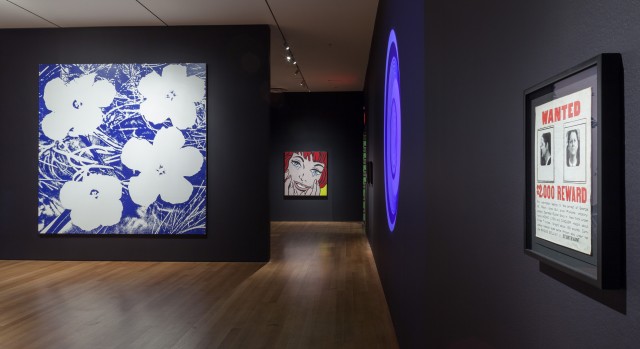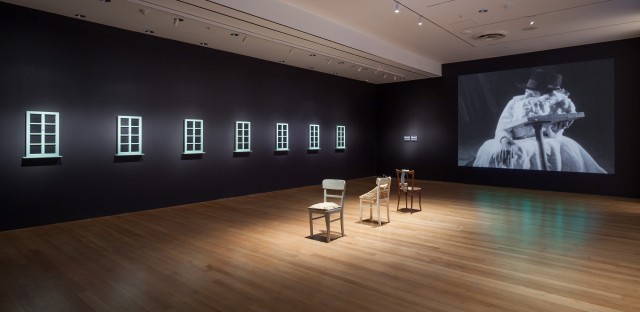
Installation view, “Sturtevant: Double Trouble,” all works by Sturtevant © Estate Sturtevant, Paris (© 2014 the Museum of Modern Art; photo by Thomas Griesel)
Museum of Modern Art
Special Exhibitions Gallery, third floor
The Sue and Edgar Wachenheim III Painting and Sculpture Gallery, Gallery 5, fifth floor
11 West 53rd St. between Fifth & Sixth Aves.
Daily through February 22, $25
212-708-9400
www.moma.org
Walking into MoMA’s “Sturtevant: Double Trouble” exhibit, you’re likely to be overcome with a feeling of déjà vu, or perhaps wonder whether you’ve actually sauntered into one of the museum’s painting and sculpture galleries featuring works by a multitude of artists. Ohio-born artist Elaine Sturtevant spent her long career — she died in May 2014, while participating in this first major American survey of her oeuvre — taking the work of others and making it her own, leaving some critics to cheer her bold individuality and others to decry her as little more than a plagiarist. “Same is a copy but it’s not the same,” she said, fiercely defending her method, which delves into wide-ranging questions of authorship, gender, and originality. “Her longstanding concern with the political, economic, and cultural circumstances that underpin art’s creation and consumption is an essential part of her work,” MoMA director Glenn D. Lowry writes in the foreword to the exhibition catalog. “‘Sturtevant: Double Trouble’ draws attention to that aspect of her bold and groundbreaking practice, suggesting that she opens the art history of her time — and ours — in new directions, challenging us to rethink many of our assumptions about what we see, how we value what we see, and the histories that our institutions perpetuate.” Sturtevant didn’t just “repeat” random works of others; instead, she asks viewers to reconsider iconic images by major artists, usually done without the express permission of those artists, aside from Andy Warhol, who let her do whatever she wanted with his films and silkscreens. In “Warhol Flowers,” she has taken an image, generally associated with femininity, by a sexually ambiguous Pop artist, and forced the viewer to reconsider it in multiple ways. In “Johns 0 through 9,” she stencils the numbers zero through nine in the style of Jasper Johns, in encaustic on a ripped piece of newspaper from the business section, adding her own element of the financial nature of art. In “Study for Muybridge, Plate #97: Woman Walking,” Sturtevant has photographed herself, naked, walking in front of re-created paintings by James Rosenquist, Johns, and Roy Lichtenstein. (Interestingly, this past November, Sturtevant’s painting “Lichtenstein, Frighten Girl” sold at Christie’s for more than $3.4 million, up from $710,500 in 2011; multiples of the Lichtenstein lithograph on which it is based, “Crying Girl,” have reached as high as $78,400.)

Installation view, “Sturtevant: Double Trouble,” all works by Sturtevant © Estate Sturtevant, Paris (© 2014 the Museum of Modern Art; photo by Thomas Griesel)
In “Duchamp Man Ray Portrait,” Sturtevant depicts her face, neck, and head covered in shaving cream, a decidedly male activity, echoing Man Ray’s 1924 gelatin silver print “Duchamp with Shaving Lather for Monte Carlo Bond.” In the collage “Working Drawing Wesselmann Great American Nude Lichtenstein Hot Dog,” Sturtevant juxtaposes works by two seminal artists, making a deliciously wry and decadent statement about women as sex objects. She also copies, er, appropriates, um, pays homage to, uh, skewers, well, echoes, eh, repeats, oh, reconfigures works by Claes Oldenburg, Jim Dine, Felix Gonzalez-Torres, Joseph Beuys, Keith Haring, Frank Stella, and Robert Gober. There are also several video installations from 2010 and 2012, further repurposing pop-culture imagery in the digital age, including re-creating the decidedly analog “Pac-Man” game as if she herself is eating up and spitting out art history. In the September-October 2005 issue of Index magazine, she told Peter Halley, in reference to criticism of her 1973 show “Studies for Warhols’ Marilyns Beuys’ Actions and Objects Duchamps’ Etc. Including Film,” at the Everson Museum of Art in Syracuse, “The reviews for that show were the same as always — that I was reviewing history, or that the pieces were all copies, blah blah blah. I realized that if I continued to work and get that kind of critique, then the work would get diluted. So I decided to wait until the mental retards caught up. And, indeed they did.” It’s a shame Sturtevant didn’t live long enough to see what everyone had to say about MoMA’s stellar survey, which continues through February 22. (On February 21 at 11:30, there will be a special Gallery Session, “20 Questions in the Wormhole,” which examines the intentions of this fascinating, exciting, and controversial “copycat artist.”)